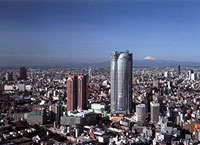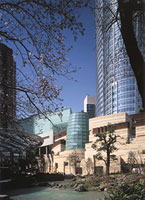|
|
|||||||
|
|
|||||||
|
|||||||
| | Web Japan >>| Trends in Japan >> | Lifestyle >> | Central Tokyo Reborn | |
|
CENTRAL TOKYO REBORN Redeveloped Areas Bursting with Cosmopolitan Verve (June 19, 2003) Central Tokyo is enjoying a renaissance as massive redevelopment projects transform little-used sections of town into shopping and entertainment hotspots. These major projects, several of which have recently been completed, each have their own unique attractions, but all have one thing in common: The resulting complexes incorporate not only office space but everything people need to live, work, and enjoy themselves in the twenty-first century, including modern residences, state-of-the-art international business facilities, and a plethora of entertainment options. The creation of these diverse new districts is further invigorating Japan's already thriving capital.
A High-Rise Cosmopolitan City in Roppongi Roppongi Hills is a multi-purpose city within a city. Besides office space, the newly completed complex includes a tower complete with an art gallery, a library, and an observation deck; a nine-screen cinema complex with seating for 2,100 people; a hotel complex containing the Grand Hyatt Tokyo and numerous first-class restaurants; an event arena and garden complete with a circular stage; four residential apartment buildings (total 800 units) that boast a highly sought after city-center location; and the headquarters of a major TV station. The centerpiece of this complex is the Roppongi Hills Mori Tower, which, at 54 floors and 238 meters high, is already one of Tokyo's newest landmarks. Green spaces and environmental considerations have been built into the design of Roppongi Hills. About 50% of the complex's total area consists of gardens, pavilions, and other open spaces. One feature that is a particularly pleasant surprise in the heart of the city is the Mohri Garden, an authentic Japanese garden complete with a pond and trees. Minoru Mori, president and CEO of Mori Building Co., describes Roppongi Hills as "a high-rise, compact city combining facilities for working, living, playing, and studying." The range of facilities available in this complex is truly stunning. Unlike past redevelopment projects where the emphasis was on office space, Roppongi Hills gives equal status to the cultural and residential facilities, shops, and restaurants. During the 2003 Golden Week holidays in late April and early May, Roppongi Hills drew some 2.65 million visitors, who came to shop, to dine, and just to look around. One thing is certain: Roppongi Hills has leapt to fame as a new Tokyo landmark. It is set to establish itself as one of the must-see attractions for visitors from elsewhere in Japan and abroad.
Business, Boutiques, and Academia in One Building With about 140 shops and restaurants, Tokyoites and visitors alike have been drawn to the new Marunouchi Building as an attractive place to spend time. The developers have been extremely selective about the commercial tenants, so the building is an excellent place to find designer boutiques and sample some of the best cuisine in Tokyo. Another defining feature of the new Marunouchi Building is that the office tenants include three prestigious universities, which have each established a presence in the building in order to be near the top-class companies that have offices there. One of the academic tenants is Japanese (a satellite office of the University of Tokyo's Faculty of Economics), one American (Harvard Business School's Japan Research Office), and one Swedish (the Tokyo office of the European Institute of Japanese Studies, part of the Stockholm School of Economics). The Marunouchi district used to be synonymous with businesspeople in offices, but the diverse attractions of the new Marunouchi building are drawing a wide range of visitors, including shoppers, tourists, working women, and students.
More Redevelopment Projects to Follow And an office complex known as Shinagawa Grand Commons opened at the east exit of JR Shinagawa railway station in April. Some well-known companies that were formerly based in the Marunouchi district have relocated their offices to this site. Among the areas due for large-scale redevelopment is land formerly occupied by the Defense Agency in Roppongi and the Nihonbashi district. These many ambitious projects are not only changing the capital's skyline; they are enriching the lifestyles of those who live in and around Tokyo by expanding the city's horizons, broadening the range of dining, shopping, and entertainment options, and providing exciting new opportunities for exchange and dialogue among businesspeople, residents, visitors, and others. Related Web SitesRoppongi Hills Grand Hyatt Tokyo Mori Building Co. Marunouchi Building University of Tokyo's Faculty of Economics Harvard Business School's Japan Research Office European Institute of Japanese Studies Caretta Shiodome (Japanese only) Nihonbashi district Copyright (c) 2004 Web Japan. Edited by Japan Echo Inc. based on domestic Japanese news sources. Articles presented here are offered for reference purposes and do not necessarily represent the policy or views of the Japanese Government. |
TOURING TOKYO (April 18, 2003) LICENSED TO ENTERTAIN (October 25, 2002) GINZA, SHIBUYA GET NEW FACES (October 17, 2001) |
|
|




